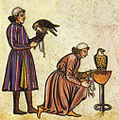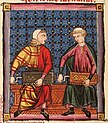Traveling within the World
Linking your favorite traveling artists across the globe

Costume during the thirteenth century in Europe was very simple for both men and women, and quite uniform across the subcontinent. Male and female clothing were relatively similar, and changed very slowly, if at all. Most clothing, especially outside the wealthier classes, remained little changed from three or four centuries earlier.[1] The century saw great progress in the dyeing and working of wool, which was by far the most important material for outer wear. For the rich, colour was very important. Blue was introduced for the first time, and became very fashionable, being adopted by the Kings of France as their heraldic colour.[2]
Men's clothing
Men wore a tunic, cote or cotte with a surcoat over a linen shirt. One of these surcoats was the cyclas, which began as a rectangular piece of cloth with a hole in it for the head. Over time the sides were sewn together to make a long, sleeveless tunic. When sleeves and sometimes hood were added, the cyclas became a ganache (a cap-sleeved surcoat, usually shown with hood of matching color) or a gardcorps (a long, generous-sleeved traveling robe, somewhat resembling a modern academic robe). A mantle was worn as a formal wrap. Men also wore hose, shoes, and headdress. The clothing of royalty was set apart by its rich fabric and luxurious furs. Hair and beard were moderate in length, and men generally wore their hair in a "pageboy" style, curling under at necklength. Shoes were slightly pointed, and embroidered for royalty and higher clergy.[3]
Working men's clothing
Working men wore a short cotte, or tunic, with a belt. It was slit up the center of the front so that they could tuck the corners into their belt to create more freedom of movement. They wore long braies or leggings with legs of varying length, often visible as they worked with their cotte tucked into their belt. Hose could be worn over this, attached to the drawstring or belt at the waist. Hats included a round cap with a slight brim, the beret (just like modern French ones, complete with a little tab at the top), the coif (a little tight white hood with strings that tied under the chin), the straw hat (in widespread use among farmworkers), and the chaperon, then still a hood that came round the neck and over the shoulders. Apart from aprons for trades like smithing, and crude clothes tied round the neck to hold seed for sowing, special clothes were not worn for working.[4]
Style gallery
5 – Cappa or chaperon |
- Men working in linen braies, tunics, and coifs, from the Maciejowski Bible, c. 1250. The man on the left wears green hose over his braies.
- Man in a coif and shirt (camisa) with gussets at the hem, from the Cantigas de Santa Maria, Spain, mid-13th century.
- Falconers wear belted tunics and coifs, 1240s.
- Young Merlin wears a short tunic with a rectangular cloak or mantle and hose. King Vortigern wears a mantle draped over both shoulders over a long gown or tunic and shoes with straps at the instep. From a manuscript of Geoffrey of Monmouth's Prophetia Merlini, c. 1250–70.
- Man in the short, hooded cape called a cappa or chaperon, c. 1250–70.
- Musicians wear two long tunics, one over the other. The tunic on the left is an early example of mi-parti or particolored clothing, made from two fabrics. Cantigas de Santa Maria, mid-13th century, Spain.
- Pan-pipe players wear tunics with hanging sleeves over long-sleeved undertunics. Both wear coifs. Cantigas de Santa Maria, mid-13th century, Spain.
Women's clothing

Overview
Dress for women was restrained. A floor length, loosely-fitted gown, with long, tight sleeves and a narrow belt was uniform. Over this was worn the cyclas or sleeveless surcoat (also worn by men). Richer women wore more embroidery, and the mantle, held in place by a cord across the chest, might be lined with fur. Women also wore hose and leather shoes, like men.[3]
Headdresses and hairstyles
Individuality in women's costume was expressed through their hair and headdress. One distinctive part of thirteenth-century women's headwear was the barbette, a chin band to which a hat or various other headdress might be attached. This hats might be a "woman's coif", which more nearly resembled a pillbox hat, severely plain or fluted. The hair was often confined by a net called a crespine or crespinette, visible only at the back. Later in the century the barbette and coif were reduced to narrow strips of cloth, and the entire hairdress might be covered with the crespine, the hair fashionable bulky over the ears. Coif and barbette were white, while the crespine might be colored or gold. The wimple and veil of the twelfth century (still seen on nuns today) was still worn, mainly by older women and widows. [3]
Style gallery
- Barbette and coif: Tomb of Eleanor of Aquitaine (d. 1204)
- Two women (probably personifications of Mercy and Truth) wear sleeveless surcoats over full gowns with sleeves narrow at the wrist. Overall they wear mantles draped over one shoulder. English psalter, c. 1220–25
- Young women in loosely belted gowns with their hair down. Jephthah's daughter, from the Morgan Bible (Maciejowski Bible), c. 1250
- Manoah's wife wears a veil and wimple. Note striped hose, c. 1250.
Sumptuary laws
The Fourth Council of the Lateran of 1215 ruled that Jews and Muslims must be distinguishable by their dress, beginning the process that transformed the conical or pointed Jewish hat from something worn as a voluntary mark of difference, to an enforced one. Previously it had worn, but had been regarded by European Jews as "an element of traditional garb, rather than an imposed discrimination".[5] A law in Breslau in 1267 said that since Jews had stopped wearing the pointed hats they used to wear, this would be made compulsory.[6] The Yellow badge also dates from this century, although in it the hat seems to have been much more widely worn.
Sumptuary laws covering prostitutes were introduced (following Ancient Roman precedent) in the 13th century: in Marseilles a striped cloak, in England a striped hood, and so on. Over time these tended to be reduced to distinctive bands of fabric attached to the arm or shoulder, or tassels on the arm.[7]
These probably reflected both a growing concern for control over the increasing urban populations, and the increasing effectiveness of the Church's control over social issues across the continent.
Footwear
References
- ^ Françoise Piponnier and Perrine Mane; Dress in the Middle Ages; p. 39; Yale UP, 1997; ISBN 0300069065
- ^ Piponnier & Mane, op cit, p. 60
- ^ a b c Payne, Blanche: History of Costume from the Ancient Egyptians to the Twentieth Century, Harper & Row, 1965
- ^ Piponnier and Mane, op cit pp. 49–52
- ^ Françoise Piponnier and Perrine Mane; Dress in the Middle Ages; p. 138, Yale UP, 1997; ISBN 0300069065. Seals from Norman Roth, op cit. Also Schreckenburg p. 15 & passim.
- ^ Medieval Jewish History: An Encyclopedia. Edited by Norman Roth, Ro...
- ^ Piponnier and Mane:139–141
Tags:
Replies to This Discussion
Events
-
2014 is the Chinese Year of the Horse
February 17, 2026 at 12am to February 5, 2027 at 12am – where & how you choose
Birthdays
There are no birthdays today
Important (read & understand)
Skype: Travelingraggyman
Email and Instant Messenger:
TravelerinBDFSM @ aol/aim; hotmail; identi.ca; live & yahoo
OR
Travelingraggyman @ gmail and icq ***

1AWARD UPDATES & INFORMATION
10,000 votes - Platinum Award
5,000 votes - Gold Award
2,500 votes - Silver Award
1,000 votes - Bronze Award
300 votes - Pewter Award
100 votes - Copper Award
Member of the Associated Posting System {APS}
This allows members on various sites to share information between sites and by providing a by line with the original source it credits the author with the creation.
Legal Disclaimer
***************We here at Traveling within the World are not responsible for anything posted by individual members. While the actions of one member do not reflect the intentions of the entire social network or the Network Creator, we do ask that you use good judgment when posting. If something is considered to be inappropriate it will be removed
Site Meter
This site is strictly an artist operational fan publication, no copyright infringement intended
Patchwork Merchant Mercenaries had its humble beginnings as an idea of a few artisans and craftsmen who enjoy performing with live steel fighting. As well as a patchwork quilt tent canvas. Most had prior military experience hence the name.
Patchwork Merchant Mercenaries.
Vendertainers that brought many things to a show and are know for helping out where ever they can.
As well as being a place where the older hand made items could be found made by them and enjoyed by all.
We expanded over the years to become well known at what we do. Now we represent over 100 artisans and craftsman that are well known in their venues and some just starting out. Some of their works have been premiered in TV, stage and movies on a regular basis.
Specializing in Medieval, Goth , Stage Film, BDFSM and Practitioner.
Patchwork Merchant Mercenaries a Dept of, Ask For IT was started by artists and former military veterans, and sword fighters, representing over 100 artisans, one who made his living traveling from fair to festival vending medieval wares. The majority of his customers are re-enactors, SCAdians and the like, looking to build their kit with period clothing, feast gear, adornments, etc.
Likewise, it is typical for these history-lovers to peruse the tent (aka mobile store front) and, upon finding something that pleases the eye, ask "Is this period?"
A deceitful query!! This is not a yes or no question. One must have a damn good understanding of European history (at least) from the fall of Rome to the mid-1600's to properly answer. Taking into account, also, the culture in which the querent is dressed is vitally important. You see, though it may be well within medieval period, it would be strange to see a Viking wearing a Caftan...or is it?
After a festival's time of answering weighty questions such as these, I'd sleep like a log! Only a mad man could possibly remember the place and time for each piece of kitchen ware, weaponry, cloth, and chain within a span of 1,000 years!! Surely there must be an easier way, a place where he could post all this knowledge...
Traveling Within The World is meant to be such a place. A place for all of these artists to keep in touch and directly interact with their fellow geeks and re-enactment hobbyists, their clientele.
© 2025 Created by Rev. Allen M. Drago ~ Traveler.
Powered by
![]()










